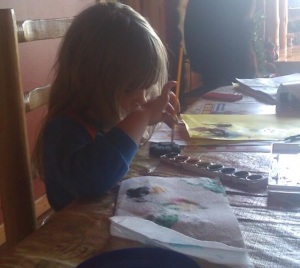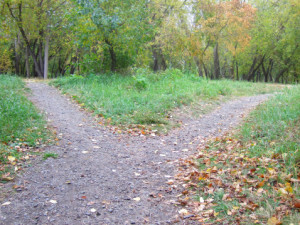This past weekend I spent two days at Brown Deer Golf Course watching 144 professional golfers on the Symetra Tour battle it out in the PHC Classic. The Symetra Tour is the step before advancing to the LPGA and the top 10 finishers on the Symtra Tour at the end of the year will earn their way onto the LPGA Tour.
9 Tips on How to Be One of the Best in the World
15 Ideas on Finding Time to Think
It seems there is never enough time for anything these days. There are so many tasks we need to get done, so many things we need to do in order to maintain some sort of pace in order to avoid getting buried by life. But, this leaves little time for contemplation. There’s just no time to think. The kind of thinking where you can get rid of distractions and do away with that little voice in your head reminding you of everything that needs to get done.
When I was a kid, and I would include my years in college, I had time to think and talk about stuff with my friends; important stuff, meaningful stuff. We would discuss life’s big questions – what do we want to do when we grow up?, who is up there in space looking back down at us?, why can’t people get along?, what are the best albums ever made?, what makes great artists so good?, how can we make the world a better place, do you think she likes me?
Even with classes and homework there was plenty of free time. And back then I didn’t waste it on TV. I watched Monty Python and the Packers games with my friends, but not much else. There also wasn’t the distraction of social media.
There are ways to get back our time. Instead of sitting in front of the TV all night and making status updates I’ve come up with some alternatives. All of these ideas I did at some point years ago. I thought if it worked so successfully back then why not go back to basics.
Here are 15 ideas on finding time to think:
Playing catch: There’s something relaxing about throwing a baseball around. Once you get into a rhythm it can be a kind of meditation.
Fishing: There’s nothing better to slow things down. It’s just you, a friend or two, a fishing pole, and the water. Most times I never even caught fish, but the conversations were great.
Riding a bike: Good exercise and you get to see things from a different perspective. As a kid I biked everywhere. It’s the only way I got anywhere sometimes. The sound of the rubber on the road can be hypnotizing.
Going for a walk: More good exercise. I don’t walk as much as I used to. In college it was the only mode of transportation I had. It makes your senses perk up.
Shooting hoops: More good exercise that forces you to concentrate and think about your shot. It’s good for focus.
Exploring/hiking: Is there anything better than getting away from it all and communing with nature? Listening to the wind blow through the trees or birds singing is calming. Add the sound of water running over rocks or a waterfall and you’ve got yourself the perfect place to stop and take a meditation break.
Building models: I loved to build model tanks and airplanes. It takes focus and discipline. When you start, it sometimes feels like it’s an impossible task because there’s so many pieces and it’s going to take forever to complete it. You can’t rush through it and it’s a good way to slow things down.
Drawing: I always loved drawing, like most kids. I took drawing and painting in college and it opened my eyes to look at things in a different way. Take an art class – it’ll get you thinking with a different part of your brain.
Looking out the window: I don’t know if anything beats daydreaming. There’s so much going on outside that you can’t help but reflect on what’s going on inside. Clouds, trees, insects, animals, and people can trigger so many thoughts.
Staring at the stars: This gets you thinking about life’s big questions. You can’t help it. It puts life into perspective looking up at the universe and looking at light that’s just getting here that might be hundreds of thousands, if not millions, of years old. You realize you are a speck yet full of possibilities.
Gardening/yard work: Getting your hands dirty reconnects you to the earth. It’s as if a chisel cracks away the shell of modern society and you and mother nature are reunited.
Planting a tree: There’s something sacred about planting a tree. Maybe because it’s going to be there for years; possibly longer than we are. It’s majestic, mighty, and unwavering.
Listening to music: I love this one. I get lost in music a lot. It’s where I go to feel like I’m alive. Music stimulates the creative side of my brain.
Road trips: This is where you can really get to know someone and know yourself a little bit better. It’s a great way to strip away the layers and be honest. It might be because you need to travel light and it gets you back to the essentials – food, shelter, sleep, and companionship.
Reading: Pick something that makes you ponder life like poetry, philosophy, mythology, or some sacred text (whatever that means to you). It elevates your thoughts.
I think this list gives us a way to get unstuck and think our way into a more positive existence. If we believe things will never change, we’re trapped. We need time to think and re-group. School has semester breaks, in football you have halftime; take time for yourself to re-think your game plan.
When do you find time for yourself? How are you able to think clearly with distractions? What are your results, or what do you hope the results will be?
“Stop Talking. I’m Painting.” A Lesson in Focus and Eliminating Distractions.
 Recently my sister decided to give my 3 1/2 year old niece some paints, brushes, and paper; figuring that she’s old enough to be able to have fun without making too much of a mess. My niece enjoys coloring books and drawing, so it seemed like a logical progression.
Recently my sister decided to give my 3 1/2 year old niece some paints, brushes, and paper; figuring that she’s old enough to be able to have fun without making too much of a mess. My niece enjoys coloring books and drawing, so it seemed like a logical progression.
The Difference Between Pros and Amateurs
 I play golf maybe once a week. My goal is to break 90, but I’m struggling to accomplish that. At times I’m getting closer, others it’s far off. I also have to take into account that the golf season in Wisconsin is six months long. By the time spring rolls around, I’m rusty and it takes months to get my swing back.
I play golf maybe once a week. My goal is to break 90, but I’m struggling to accomplish that. At times I’m getting closer, others it’s far off. I also have to take into account that the golf season in Wisconsin is six months long. By the time spring rolls around, I’m rusty and it takes months to get my swing back.
Staying Focused
 This past weekend I went on a golf outing with some friends. Golf is a challenging game. There are the physical components to it; you have to be lined up to the ball properly, take the proper swing, etc, but the main part of the game is mental.
This past weekend I went on a golf outing with some friends. Golf is a challenging game. There are the physical components to it; you have to be lined up to the ball properly, take the proper swing, etc, but the main part of the game is mental.
Golf forces you to concentrate on the moment; the shot at hand. When I think about hitting a good shot and focus on that I can often do it. But, when I think about the previous shot or the next shot, it affects my score – negatively.
When I Win the Lottery
 I’ve been thinking lately about what I would do when I win the lottery. It started when I sent back my Publisher’s Clearing House Sweepstakes entry. I could win $7,000 a week for life. That’s $364,000 a year! That’s way more than I make now. That’d be sweet.
I’ve been thinking lately about what I would do when I win the lottery. It started when I sent back my Publisher’s Clearing House Sweepstakes entry. I could win $7,000 a week for life. That’s $364,000 a year! That’s way more than I make now. That’d be sweet.Gaining Confidence and Success Through Visualization
 We are more confident when we are in comfortable situations. When we’re surrounded by people and places we know, it gives us a sense of security. We feel relaxed, loose. We perform better under these conditions.
We are more confident when we are in comfortable situations. When we’re surrounded by people and places we know, it gives us a sense of security. We feel relaxed, loose. We perform better under these conditions.Who Matters to You?
 I spent some time this past weekend cleaning up my Twitter account. Apparently there’s some magic formula where you can’t follow a certain amount of people more than people who follow you. So I went through the list, and decided to un-follow anyone who wasn’t providing value to me. It gave me space to follow new people; people who matter to me.
I spent some time this past weekend cleaning up my Twitter account. Apparently there’s some magic formula where you can’t follow a certain amount of people more than people who follow you. So I went through the list, and decided to un-follow anyone who wasn’t providing value to me. It gave me space to follow new people; people who matter to me.
It was interesting to go through the list; some people I have a personal connection with, so those are most valuable. Then there are those that share awesome information. I enjoy reading what they post and I learn a lot from them. They were keepers.
4 Lessons from the Oscars on Achieving Life-Long Dreams
 Watching the Academy Awards I was struck by the speeches of the winners. I could sense the struggles everyone went through; the rejection, the under-appreciation, the menial jobs, the ramen noodle diets, all in the pursuit of achieving their life-long dreams.
Watching the Academy Awards I was struck by the speeches of the winners. I could sense the struggles everyone went through; the rejection, the under-appreciation, the menial jobs, the ramen noodle diets, all in the pursuit of achieving their life-long dreams.
Choose Your Own Adventure
 Remember those Choose Your Own Adventure books when we were kids? You would get to a crucial point in the story and you would be left with a decision to make because you couldn’t continue until you picked one of the two options presented (technically option three was you could stop reading). The options would be something like, “to open the door turn to page 39” or “to run up the stairs turn to page 51.” What to do? What to do? You thought about it, made your decision, and flipped the pages to see what would happen next.
Remember those Choose Your Own Adventure books when we were kids? You would get to a crucial point in the story and you would be left with a decision to make because you couldn’t continue until you picked one of the two options presented (technically option three was you could stop reading). The options would be something like, “to open the door turn to page 39” or “to run up the stairs turn to page 51.” What to do? What to do? You thought about it, made your decision, and flipped the pages to see what would happen next.
Recently, I’ve been thinking about those books and saying to myself, “isn’t life just a constant choose your own adventure story?” Only now our decisions have more consequences than just reading a different part of a story. Yet, with these seemingly important decisions, we routinely do the same thing over and over without really thinking about it. Then when things don’t turn out how we want them to, we’re surprised. We end up in jobs and relationships that don’t satisfy us when we don’t think enough about what we want.
There have been plenty of times I’ve said to myself, “I should have known better.” If I had taken some time to think about what I was doing I might have chosen a better option. I’m not talking about “do you want soup or salad?” I’m talking about big life decisions. I think I’m going to try something new and have a monthly assessment of where I’m at with my life and where I want to go and see what decisions I need to make in order to get there. (Maybe I’ll discover it needs to be weekly, that’s part of the fun of trying this, who knows where this will take me).
What page do you want to turn to in your life story? What will you do to assess the decisions you need to make in order to get there?
Here’s to happy and fulfilling adventures!


Follow Me!